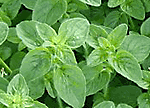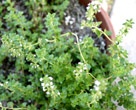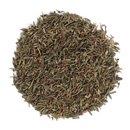Thyme herb nutrition facts
Thyme herb is packed with numerous health-benefiting phytonutrients (plant-derived compounds), minerals, and vitamins that are essential for overall wellness. One of the popular culinary herb plants, thyme originally is native to southern Europe and the Mediterranean regions.
Botanically, it belongs to the family of Lamiaceae, in the genus of Thymus.
There are many subspecies of which the most popular variety is Thymus vulgaris or French thyme.

|
 |
| French Thyme-Thymus vulgaris | Lemon thyme-T.x citriodora, Courtesy: Flickr: wnbrgr. |
The thyme plant is a perennial shrub with a thin woody base and square stems. It reaches about 15 to 30 cm in length, featuring small, light green with paler underneath, slightly curved aromatic leaves. Small, fragrant, lilac, or white color flowers appear in summer.
The other commonly grown varieties of thyme are lemon thyme (T.x citriodora), caraway thyme (T. herba barona) and wild thyme (T. septyllum). Either leaves as well as flowering tips; fresh or dried used for culinary purposes.
Health benefits of Thyme herb
Thyme contains many active principles that are known to have disease-preventing and health-promoting properties.
Thyme herb contains thymol, one of the important essential oils. Thymol has been found scientifically to have antiseptic, and anti-fungal characteristics. The other volatile oils in thyme include carvacrol, borneol, and geraniol.
Thyme contains many flavonoid phenolic antioxidants like zeaxanthin, lutein, apigenin, naringenin, luteolin, and thymonin. Fresh thyme herb has one of the highest antioxidant levels among herbs, a total ORAC (Oxygen Radical Absorbance Capacity) value of 27,426-µmol TE/100 g.
Thyme is packed with minerals and vitamins that are essential for optimum health. Its leaves are one of the richest sources of potassium, iron, calcium, manganese, magnesium, and selenium. Potassium is an important component of cells and body fluids that helps control heart rate and blood pressure. Manganese is used by the body as a co-factor for the antioxidant enzyme, superoxide dismutase. Iron is essential for red blood cell formation.
The herb is also a rich source of many important vitamins such as B-complex vitamins, β-carotene, vitamin-A, vitamin-K, vitamin-E, vitamin-C, and folic acid.
Thyme provides 0.35 mg of vitamin B-6 or pyridoxine; furnishing about 27% of daily recommended intake. Pyridoxine keeps up GABA (beneficial neurotransmitter in the brain) levels in the brain which has a role as a stress buster.
Vitamin-C helps the human body develop resistance against infectious agents and scavenge harmful, pro-inflammatory free radicals.
Vitamin-A is a fat-soluble vitamin and antioxidant that is required to maintain healthy mucosa and skin and is also essential for vision. Consumption of natural foods rich in flavonoids like vitamin A and beta-carotene helps protect from lung and oral cavity cancers.
Thyme leaves offer significant levels of quality phytonutrients profile. Just 100 g of fresh leaves provides (% of Recommended daily allowance)
38% of dietary fiber,
27% of vitamin B-6 (pyridoxine),
266% of vitamin-C,
158% of vitamin-A,
218% of iron,
40% of calcium,
40% of magnesium, and
75% of manganese
However, zero cholesterol.
| Principle | Nutrient Value | Percent of RDA |
|---|---|---|
| Energy | 101 Kcal | 5% |
| Carbohydrates | 24.45 g | 18% |
| Protein | 5.56 g | 10% |
| Total Fat | 1.68 g | 8.4% |
| Cholesterol | 0 mg | 0% |
| Dietary Fiber | 14.0 g | 37% |
| Vitamins | ||
| Folates | 45 µg | 11% |
| Niacin | 1.824 mg | 11% |
| Pantothenic acid | 0.409 mg | 8% |
| Pyridoxine | 0.348 mg | 27% |
| Riboflavin | 0.471 mg | 36% |
| Thiamin | 0.48 mg | 4% |
| Vitamin-A | 4751 IU | 158% |
| Vitamin-C | 160.1 mg | 266% |
| Electrolytes | ||
| Sodium | 9 mg | 0.5% |
| Potassium | 609 mg | 13% |
| Minerals | ||
| Calcium | 405 mg | 40.5% |
| Iron | 17.45 mg | 218% |
| Magnesium | 160 mg | 40% |
| Manganese | 1.719 mg | 75% |
| Manganese | 106 mg | 15% |
| Zinc | 1.81 mg | 16.5% |
| Phyto-nutrients | ||
| Carotene-ß | 2851 µg | -- |
Selection and storage

|
| Dried thyme herb leaves. |
Both fresh and dried forms of thyme herb can be available in the herb store. Buy fresh thyme whenever possible since it is superior in nutrients and rich in flavor. The leaves of fresh thyme should feature light green, and be free from any dark spots or yellowing.
Fresh thyme should be stored in the refrigerator wrapped in a slightly dampened paper towel. Dried thyme can be kept in a tightly sealed glass container and stored in a cold, dark, and dry place, where it will stay fresh for up to six months.
Culinary uses
Thyme herb imparts intense flavor to the recipes, and therefore, should be added sparingly. In order to keep its fragrance and flavor intact, thyme herb is generally added at the final stages of the recipes. It is done to prevent evaporation of its essential oils in cases of extended cooking methods.
Here are some serving methods:

|
| Thyme herb used to marinate chicken and vegetable recipes. Photo courtesy: lizadaly |
Thyme herb tea is a popular health drink.
Thyme has been used in the preparation of season soups, and sauces.
The herb is one of the ingredients in bouquet garni along with bay leaf, parsley, and celery.
-
Thyme, along with other spicy items, has been used to marinate and stuff to chicken, fish, and meat recipes.
Medicinal uses
Thyme contains many important essential oils, which are found to have antiseptic and anti-fungal applications.
Throat gargling with tepid thyme water or drinking a few sips of thyme tea may help relieve coughs, sore throat, and bronchitis symptoms.
In the pharmacy, thyme-based formulations have been used as an antiseptic mouthwash in the treatment of caries and gingivitis. (Medical disclaimer).
≺≺ Back to Herbs from Thyme herb. Visit here for an impressive list of all variety of herbs with complete illustrations of their nutrition facts and health benefits.
≺≺ Back to Home page.
Further Resources:
Thyme Planting -Herb Growing in South Africa. pdf
Stanford School of Medicine Cancer information Page- Nutrition to Reduce Cancer Risk.